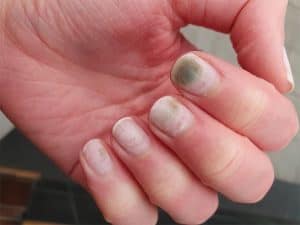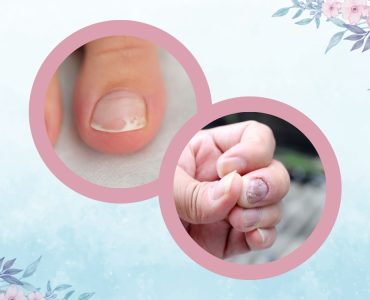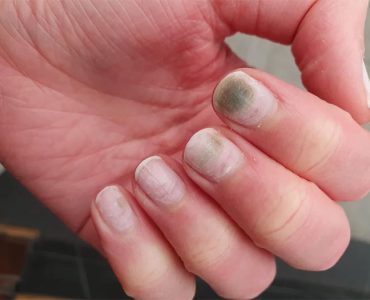Nail fungus is a common condition that affects millions of people worldwide, causing discomfort and embarrassment. Unfortunately, there is a lot of misinformation surrounding this topic, making it challenging to separate fact from fiction.

In this article, we will debunk some common myths about nail fungus and present you with evidence-based facts to help you better understand this condition. By dispelling these myths and providing accurate information, we aim to empower you with the knowledge to make informed decisions about prevention, treatment, and overall nail health.
Myth #1: Nail Fungus Only Affects Unhygienic Individuals
The belief that nail fungus is exclusively a result of poor hygiene is a prevalent myth that needs to be debunked. While maintaining good hygiene is important for overall nail health, it is not the sole determinant of whether an individual develops nail fungus. Let’s delve deeper into this myth and uncover the truth about the factors contributing to nail fungus.
The Fallacy of Hygiene as the Sole Determinant
Contrary to popular belief, nail fungus can affect individuals who follow meticulous hygiene practices. Cleanliness alone does not guarantee protection against nail fungus. Fungi responsible for nail infections thrive in warm, moist environments, making anyone susceptible to their growth, regardless of their hygiene habits.
Genetic Predisposition and Nail Fungus
Genetics play a significant role in determining an individual’s susceptibility to nail fungus. Some people have a genetic predisposition to fungal infections, making them more vulnerable even with proper hygiene practices. Inherited factors can affect the strength of the immune system’s response to fungal invasions, increasing the likelihood of developing nail fungus.
Underlying Health Conditions and Nail Fungus
Certain underlying health conditions can weaken the immune system and make individuals more susceptible to nail fungus. Conditions like diabetes, circulatory disorders, and immune system disorders compromise the body’s defense mechanisms, providing an ideal environment for fungal infections to thrive. It is essential to understand that nail fungus is not solely a result of poor hygiene but can be influenced by other health factors.
Weakened Immune System and Nail Fungus
A weakened immune system can also contribute to the development of nail fungus. Factors such as chronic stress, inadequate nutrition, or prolonged use of immune-suppressing medications can compromise the body’s ability to fight off fungal infections effectively. Therefore, even individuals with good hygiene practices can be at risk if their immune system is compromised.
Myth #2: Nail Fungus is Easily Cured with Home Remedies
One prevailing myth surrounding nail fungus is that it can be easily cured with simple home remedies. While natural remedies may offer temporary relief or improvement, it is important to understand their limitations. Let’s explore this myth in detail and uncover the truth about treating nail fungus at home.
Limitations of Home Remedies
It’s important to acknowledge that home remedies may not provide a definitive cure for nail fungus. While some remedies, such as vinegar or tea tree oil, have antifungal properties, their effectiveness in treating severe or persistent cases of nail fungus is limited. These remedies may help alleviate mild symptoms or prevent further fungal growth but are often insufficient to eradicate the infection completely.
Read This Next:
Complex Nature of Nail Fungus Infection
Nail fungus infections are typically stubborn and deeply rooted in the nail bed. The fungi penetrate the nail and form a protective barrier, making it difficult for home remedies to reach and eliminate them completely. The infection may persist despite diligent application of home remedies, leading to frustration and disappointment for those seeking a quick and easy solution.
Professional Medical Intervention
In many cases, professional medical intervention is necessary to effectively treat nail fungus. Healthcare professionals can accurately diagnose the infection and recommend appropriate treatment options based on the severity and extent of the condition. Prescription medications, such as oral antifungal drugs or topical treatments, are often required to address the underlying infection and promote nail healing.
Over-the-Counter Treatments
While over-the-counter (OTC) treatments for nail fungus are available, their effectiveness varies, and they may not be suitable for all cases. OTC antifungal creams, ointments, or nail lacquers may help manage mild infections or prevent recurrence after medical treatment. However, they may not provide a complete cure for severe or chronic nail fungus. Consulting a healthcare professional is crucial to determine the most appropriate treatment approach.
Importance of Timely and Effective Treatment
Nail fungus is a progressive condition that tends to worsen over time if left untreated. Relying solely on home remedies without seeking professional guidance can result in delayed treatment and potential complications. It is important to recognize the limitations of home remedies and prioritize timely and effective medical intervention for the best chances of successful treatment.
Myth #3: Nail Fungus Will Disappear on Its Own
A common misconception surrounding nail fungus is the belief that it will eventually disappear without any intervention. Unfortunately, this myth can lead to delayed treatment and potentially worsen the condition. Let’s delve into this myth and understand why nail fungus requires proactive measures for effective resolution.
Persistence of Nail Fungus
Nail fungus is a persistent infection that tends to linger and progress if left untreated. The fungi responsible for nail infections are resilient and can survive in the nail bed for an extended period. Without appropriate treatment, the infection can persist for months or even years, leading to further damage to the nails and surrounding tissues.
Potential Consequences of Untreated Nail Fungus
Ignoring nail fungus and hoping it will go away on its own can have serious consequences. As the infection progresses, the affected nails may become thickened, discolored, brittle, and crumbly. In severe cases, the infection can cause pain, discomfort, and difficulty in walking or performing daily activities. Additionally, untreated nail fungus can spread to other nails or even to other individuals, prolonging the healing process.
Progression of Nail Fungus
Nail fungus typically starts with a small white or yellow spot under the nail, often unnoticed in the early stages. Over time, the infection spreads deeper into the nail, leading to discoloration, thickening, and distortion. The longer the infection persists, the more challenging it becomes to treat, making early intervention crucial for better outcomes.
Importance of Timely Treatment
Seeking prompt treatment for nail fungus is vital to prevent its progression and minimize the potential complications. Healthcare professionals can accurately diagnose the infection, assess the severity, and recommend appropriate treatment options based on individual needs. Early intervention increases the likelihood of successful treatment and faster resolution of the infection.
Comprehensive Treatment Approach
Effective treatment of nail fungus often requires a comprehensive approach that combines medical interventions, lifestyle modifications, and proper nail care. This may involve the use of oral antifungal medications, topical treatments, or a combination of both. Additionally, maintaining good foot and nail hygiene, keeping nails trimmed and dry, and avoiding moist environments can support the healing process.
Read This Next:
Myth #4: Nail Polish Can Mask or Cure Nail Fungus
There is a common misconception that using nail polish can either mask or cure nail fungus. This myth can lead to ineffective management of the condition and further complications. Let’s explore this myth in detail and understand the limitations of nail polish when it comes to treating nail fungus.
Nail Polish as a Masking Agent
Some individuals believe that applying nail polish can hide the appearance of nail fungus, making it less noticeable. While nail polish can temporarily mask the discoloration or deformities caused by nail fungus, it does not address the underlying infection. The fungi responsible for nail fungus continue to thrive and spread beneath the nail surface, unaffected by the cosmetic covering.
Nail Polish and Fungal Growth
Nail polish creates an occlusive barrier on the nail, trapping moisture and creating an environment conducive to fungal growth. Fungi thrive in warm, moist conditions, and by sealing the nail with polish, you create an environment that promotes their multiplication. This can lead to the worsening of the infection and make it more challenging to treat in the long run.
Ineffectiveness of Nail Polish as a Cure
Nail polish, whether clear or colored, does not possess antifungal properties capable of eradicating nail fungus. While there are nail polishes marketed as antifungal, their effectiveness is limited, and they may not be sufficient for treating moderate to severe cases of nail fungus. Relying solely on nail polish as a cure can result in the progression of the infection and delay the appropriate treatment.
Importance of Proper Treatment
To effectively treat nail fungus, it is essential to address the underlying infection rather than attempting to mask or cure it with nail polish. Seeking professional medical advice is crucial for accurate diagnosis and determining the most appropriate treatment plan. Healthcare professionals may prescribe oral antifungal medications, topical treatments, or a combination of both to target the infection at its source and promote nail healing.
Nail Care Practices
While nail polish may not be a cure for nail fungus, practicing proper nail care can support the treatment process. This includes keeping the nails clean, trimmed, and dry to prevent the accumulation of moisture that fosters fungal growth. Removing nail polish periodically allows for better inspection and monitoring of the infection’s progress.
Myth #5: Nail Fungus is Contagious and Highly Infectious
There is a common misconception that nail fungus is highly contagious, leading to the fear of spreading the infection to others or contracting it easily. However, the truth about the contagiousness of nail fungus differs from this myth. Let’s explore this myth and uncover the facts about the transmission and contagiousness of nail fungus.
Level of Contagion
Contrary to popular belief, nail fungus is not highly contagious. It is not easily transmitted from person to person through casual contact or sharing personal items. The fungi responsible for nail fungus infections require specific conditions to thrive, and direct contact with an infected individual’s nails is usually needed for transmission.
Transmission Routes
Nail fungus can be transmitted indirectly through the sharing of items such as nail clippers, nail files, or footwear, especially in situations where there is close and prolonged contact with an infected individual. However, the likelihood of transmission is relatively low compared to other common contagious conditions, such as fungal skin infections.
Preventive Measures
Practicing good personal hygiene and taking preventive measures can minimize the risk of spreading nail fungus. It is important to avoid sharing personal items that come into contact with infected nails and to maintain proper foot and nail hygiene. Regularly washing and drying the feet, wearing clean socks made of breathable materials, and keeping nails clean and trimmed are important preventive practices.
Read This Next:
Susceptibility to Nail Fungus
While nail fungus is not highly contagious, certain individuals may be more susceptible to developing the infection. People with compromised immune systems, individuals with a family history of nail fungus, those who frequently expose their feet to moist environments (e.g., public swimming pools, communal showers), or those who have experienced a previous nail injury are at a higher risk of developing nail fungus.
Self-Care and Treatment
If you suspect you have nail fungus, it is important to seek proper medical diagnosis and treatment. While the infection may not be highly contagious, prompt treatment can prevent its progression, minimize the risk of spreading to other nails, and reduce the potential for transmission to others. It is advisable to consult a healthcare professional for accurate diagnosis and guidance on the most appropriate treatment options.
Myth #6: Nail Fungus Can Only Affect Toenails
There is a common misconception that nail fungus exclusively affects toenails and cannot occur on fingernails. However, the truth about nail fungus extends beyond this myth. Let’s explore this myth and uncover the facts about the potential involvement of both toenails and fingernails in nail fungus infections.
Nail Fungus on Toenails
It is true that nail fungus commonly affects toenails. The warm and moist environment inside shoes, combined with the increased exposure to potential sources of fungal infections in public places like swimming pools or locker rooms, makes toenails more susceptible to fungal growth. The fungal infection can cause discoloration, thickening, brittleness, and distortion of the affected toenails.
Nail Fungus on Fingernails
Contrary to the myth, nail fungus can also affect fingernails. While less common than toenail infections, fungal infections can develop on the fingernails as well. Fingernail fungus often occurs due to factors such as excessive moisture, prolonged exposure to water, trauma to the nail, or even through cross-contamination from an existing toenail infection. The appearance and symptoms of fingernail fungus may be similar to those on the toenails.
Similarities and Differences in Treatment
The treatment approaches for toenail and fingernail fungus are generally similar. They may include topical antifungal medications, oral antifungal drugs, or a combination of both, depending on the severity of the infection. However, some variations may exist due to factors like the thickness of toenails, slower growth rate of toenails compared to fingernails, and potential interactions with daily activities (e.g., wearing closed-toe shoes). It is essential to consult a healthcare professional for an accurate diagnosis and personalized treatment plan.
Importance of Seeking Professional Diagnosis
Nail fungus can have similar appearances to other nail conditions, such as psoriasis or trauma-related nail changes. Seeking professional diagnosis is crucial to differentiate between different nail conditions and determine the most appropriate treatment. Healthcare professionals can perform tests, such as a nail sample examination or fungal culture, to confirm the presence of nail fungus and guide the treatment process accordingly.
Preventive Measures
Regardless of whether nail fungus affects toenails or fingernails, practicing preventive measures is essential. Maintaining good nail hygiene, keeping nails clean and dry, avoiding prolonged exposure to moisture, wearing breathable footwear, and regularly inspecting the nails for any signs of infection can help minimize the risk of developing nail fungus.
Conclusion
In conclusion, it is essential to separate myths from facts when it comes to nail fungus. By debunking common misconceptions and providing evidence-based information, we can better understand this condition and take appropriate measures for prevention and treatment.
Remember that nail fungus is a common problem that can affect anyone, regardless of age or lifestyle. Maintaining good foot and nail hygiene, avoiding moist environments, wearing breathable footwear, and seeking prompt treatment are all crucial steps in preventing and managing nail fungus.








